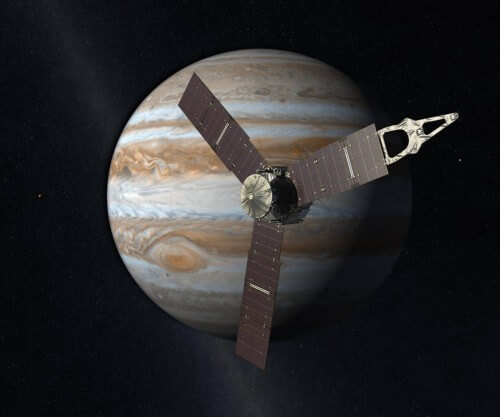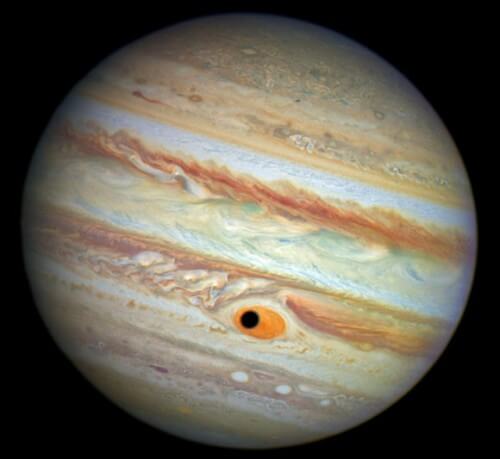NASA's Juno probe continues its five-year journey to the planet Jupiter, and today it broke the record for the furthest probe from the Sun that uses solar energy to operate its electronic devices. Juno is now 793 million kilometers from the Sun.

NASA's Juno probe continues its five-year journey to the planet Jupiter, and today it broke the record for the furthest probe from the Sun that uses solar energy to operate its electronic devices. Juno is now 793 million kilometers from the Sun.
Juno thereby broke the previous record set by the European probe Rosetta in October 2012, when, on its way to rendezvous with a comet, it reached a distance of 792 million kilometers from the Sun. However, the Rosetta probe was designed to eventually operate closer to the Sun, due to the comet's elliptical orbit, which brought it closer to the Sun by the time Rosetta reached it in 2014. Juno, on the other hand, is planned to continue operating at this distance throughout its mission and later even reach a maximum distance of 832 million kilometers from the Sun.
Jupiter's distant orbit, which is about 5 times the distance from the Sun to Earth, presented a difficult challenge to mission engineers. Juno is not the first spacecraft to operate from such a great distance, such as "New Horizons" which made headlines recently when it first explored Pluto, which is even further away from Jupiter. However, so far these spacecraft have used heat energy produced from the radioactive substance plutonium 238 that NASA uses in "radioisotopic thermoelectric generators" (RTG) that are able to operate and provide electrical energy for decades without interruption. However, since there was a shortage of the radioactive material at the time the spacecraft was built, and along with the fact that significant technological progress had been made in the output efficiency of solar panels, NASA preferred to use this technology for the Juno mission.
Juno has three solar panels that are mounted symmetrically between the six sides of its hexagonal body, and the length of each of them is 9 meters (except for one at the end of which a magnetometer was mounted to keep it away from the body of the spacecraft and its magnetic field, which could damage the instrument's measurements). Together, the solar panels include 18,698 separate solar cells, which generate the electrical energy from sunlight. It does sound very impressive, and indeed near Earth Juno's solar panels will be able to supply 14 kilowatts, but at the vast distance of Jupiter they will supply it with only 500 watts, which should be enough for the spacecraft's scientific instruments, which are very frugal in their electricity consumption.

Scott Bolton, the mission's principal investigator from the Southwest Research Institute in San Antonio, Texas, said in a NASA announcement: "It's cool that we've reached [this] milestone and that our persistent team of engineers and scientists can record another "achievement First" in space exploration, but the best is yet to come. We achieve these records and venture to such a great distance for a specific reason - to better understand the largest world in the solar system and thus to better understand where we came from."
Juno is expected to reach Jupiter on July 4 this year, a date that coincidentally falls on American Independence Day. Juno's mission will last about 16 months, during which it will investigate the internal composition of Jupiter through its outer cloud layer, the magnetosphere (the huge magnetic field that Jupiter creates in the space around it) and the aurora phenomena at its poles (the polar glow). Juno will try to study the formation of Jupiter, which is the largest planet in the solar system, and its mass is greater than all the other planets combined. In fact, the composition of Jupiter is very similar to that of the Sun - it is mainly composed of hydrogen and helium - and is sometimes considered a "failed star", one that during its formation did not add enough material to be large enough for nuclear fusion processes to occur in its core. Understanding its formation will allow a better understanding of the formation of the entire solar system and other solar systems throughout the universe.
It is worth reminding amateur astronomers that NASA invites you to participate in the public educational project of the mission, the visible light camera "Juno-Cam", which will take spectacular pictures of Jupiter from the closest distance ever to it (of about 5000 km above the surface of the clouds of justice). NASA invites amateur astronomers to upload and attach amateur photos of Jupiter and participate in conversations and votes in which the sites to be photographed by the camera will be determined.
- For NASA's announcement about breaking the record
- To the site where the discussions and votes on the Juno-Cam camera take place

3 תגובות
hi abby, right now? This marks their 293rd day at the station.
A question to Elisef Kosman how long the Shana team is currently in space ie as of now
It may be possible to use solar panels of this type for daily use. If this is possible then this is a classic case where development for space needs is applied to useful needs. I am calling on engineers to take this as a challenge.